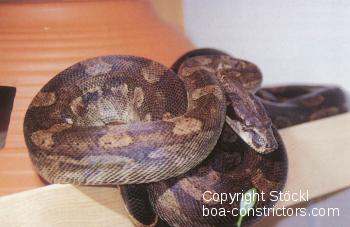Boa constrictor nebulosa
Distribution areaIsland Dominica (Lesser Antilles)
Estimated average length of mature females up to 10 ft
Particularity often addicted to birds as a prey
Taxonomic status Designated in app. II of the CITES convention
Boa constrictor nebulosa information | Dominicaboa information | size of Boa c. nebulosa | Boa c. nebulosa breeders | Boa c. nebulosa offspring | clouded boas for sale | information on Clouded Boas | true Boa c. nebulosa | size of Boa c. nebulosa
Boa c. nebulosa - Clouded Boa
The island state of Dominica (which should not be confused with the Dominican Republic), which became independent from Great Britain in 1978, is mostly covered with rainforest.
A comprehensive and exemplary network of nature reserves provides the rich fauna and flora of the island with an optimal degree of protection. As opposed to the snakes living on St. Lucia, the local Boa constrictor have a safe domicile, and their existence is by no means threatened.
Dominica has the highest peaks found in the Lesser Antilles. These mountains are of volcanic origin. The island has a comparatively small surface area, being just 47 km (29.2 miles) long and 21 km (13 miles) wide.
The climate prevailing on Dominica is tropical and alleviated by northeast winds. The rains last from July to October, which is the hottest season. These months are characterized by heavy rainfall which often results in flooding and landslides. The hurricane season falls in the last summer months. As Dominica lacks fine sandy beaches and an international airport, tourism lives in the shadows (at least compared to other Caribbean islands).
The ‘Clouded boa’, as it is called in English-speaking countries, shows a grayish brown ground coloration which subtly reflects the typical Boa constrictor pattern. The Dominican boa owes its common name to this ‘nebulous’ pattern. Also, this snake possesses the largest number of saddle patches observed in any subspecies of Boa constrictor.
Boa c. nebulosa was introduced into German herpetoculture at around the same time as Boa c. orophias. In 1991, the Munich breeder mentioned earlier also purchased three pairs of adult Dominican boas in the Netherlands. Although the documents told a different story, these animals had probably been collected in the wild. They nevertheless acclimatized well and produced offspring regularly from 1995.
We believe that all Boa c. nebulosa kept in Europe are descended from this ‘Munich’ bloodline.
During the 1990s, we also had some experience with Dominican boas. Our breeding male turned out to be a stubborn bird-eater which would only accept chicks. Our breeding group consisted of peaceful and relatively small specimens; the adult snakes kept by the Munich breeder were veritable furies. We have never witnessed more aggressive boas. Also, one of the females had the respectable length of almost 2.5 m (8.2 ft), and she was very sturdy, too.
Other aspects of the Munich bloodline of Boa c. nebulosa deserve being mentioned. After a feeding, one of our two males suddenly suffered from a total paralysis of its rear body. A radiograph proved that the joints connecting the vertebrae of the backbone had ossified and grown together, which resulted in the backbone’s stiffening in this region. The sudden mechanic strain which accompanied the muscular contractions during the strangling of the prey caused a fracture in one of these areas. The snake consequently suffered from paraplegia and had to be euthanized. When we discussed this case with other keepers of Boa c. nebulosa, we learned that similar cases with the same symptoms had occurred. As it stood, it could not be excluded that these snakes were suffering from a hereditary disease. Because other bloodlines were not available in Europe (nor have become available even today), we decided to refrain from keeping and breeding this subspecies.
As for the rest, the further history of Boa c. nebulosa in German herpetoculture strikingly resembles that of Boa c. orophias: Saturation of the market within a short span of time, dropping prices, and finally giving up on any attempts to breed Dominican boas. Of course, the backbone problems, which became public very soon, did not help the popularity of these animals.




